Väinö Helgesson
print this pageGirona - Gävle. On the shores of two seas. From the Mediterranean to the Gulf of Bothnia. 1880 - 1914
01 City
In 1869, large parts of central Gävle burned down. Rebuilding the city totally altered the city center north of the river.

The new city plan would prevent future fires and therefore, the splendid Esplanade was built, stretching from north to south through the center of the city. Nygatan, being broad, would provide a firebreak from east to west.
Building wooden houses were no longer allowed in the central city.
From the tower on the old Town Hall, around 1905, you can see the rebuilt, new Town Hall, the first building to the right. The building to the left, with the tower, is the Gevalia Palace, opened in 1892. Several so-called palaces, examples of late 19th century architecture, are Centralpalatset, at the Central Station, and Dalapalatset, in Brynäs. The palaces housed splendid state apartments, offices and shops. In the middle of the Esplanade you can see the new theater, built in the 1870's, fashioned after the Paris Opera.

Norra Strandgatan came to be dominated by several beautiful buildings. The Masons Lodge, with its stepped gable, was built in 1871, designed by architect J.F. Åbom. In 1901, in time for the Industry and Crafts Exhibition, the impressive Grand Hotel was finished. The Central Bridge, with lovely gaslights, was opened the same year. At the northern edge of the bridge, you can see one of the small steamboats that took passengers to different docks along Norrlandet. The rivers are important to both cities, but the people in Gävle have never experienced that their river has dried up which seems to has happened in Girona. However,itŽs a fact that the land elevation, still active after the last Ice Age, makes the entrance to Gävle from seaside more and more narrow.

Along the wintry Norra Rådmansgatan, from the north toward the old Town Hall, you can see two kick-sleds, a typical means of transportation in Swedish winters. Maybe the snow seldom falls in Girona but however according to the image it seems to be a bit cold along Carme street.

In 1819, Kungsbron (King's Bridge) was opened with pomp and circumstance. King Karl Johan himself and Crown Prince Oscar marched over the bridge to music and cheers. The bridge was torn down in the 1960's, but the railings can be seen along the embankments of the Gavle River. The courthouse was built in 1784-1790, a Neo-Classicist style, designed by Stockholm director C.F. Adelcrantz. The courthouse was badly damaged in the city fire of 1869 and its restoration led to large changes of the exterior.
The city fire did not affect the city south of the Gävle River. Large parts of the old wooden neighborhoods exist today, preserved in the neighborhood called Gamla Gefle. Seamen, craftsmen and workers lived in the picturesque but inconvenient houses. Today, the neighborhood has a very different status and many artists live here, among others.
02 Industries
Gävle is and has long been an industrial city. It's known for its great variety of companies, a contrast to many Swedish cities at this time, which were often dependent upon a single large company.
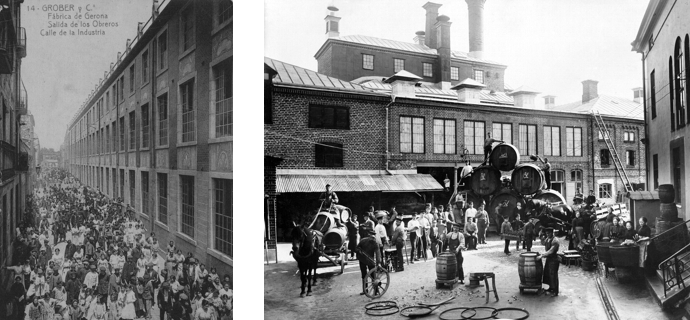
Between the mid 1850's and the early 1870's, five breweries were built in Gävle. Svagdricka (small beer), soda pop, beer and mineral water were produced on a large scale and were sold in all of the northern provinces. In this picture from Ångbryggeriet (the Steam Brewery) in 1894, you can see the workers in front of the large beer kegs. The five women could be from Dalarna, a region bordering on Gävle. It was common for the Dala girls to work at the breweries on their long journeys looking for employment.
In Gävle, as well as in Girona, big industrial buildings were often placed in the city center, quite often designed by architects and therefore beautiful from the outside but probably with poor working conditions inside.
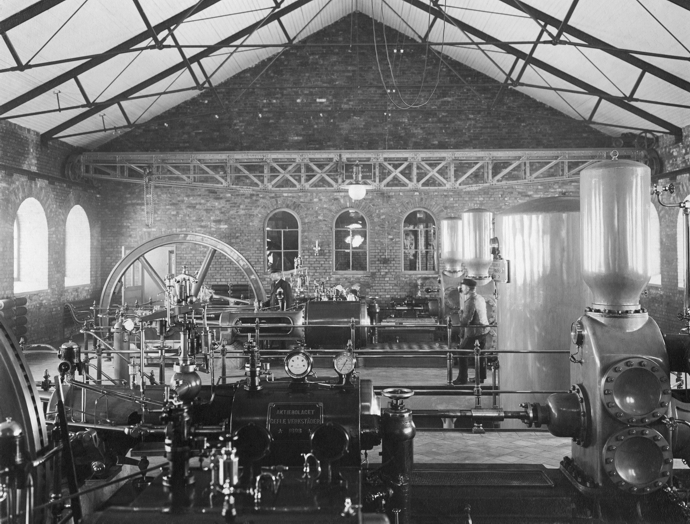
During the second half of the 19th century, problems concerning health and hygiene attracted increasing attention. A critical factor for dealing with the state of health was dealing with the questions of water supply and sewage. When they stopped taking drinking water from the Gavle River, this was a huge improvement. The water works were moved to Sätraåsen in 1898, which meant access to a fresh and pure water table. Appropriately, the new water station was named Hälsan (Health).

In the 1890's, electricity began to be used as a source of power. Electricity was important to the city's industries. Power stations were built along the Gavle River, at Hagaström and Strömdalen. This is a picture of the work environment from one of the modern substations, which was built on Ruddammsgatan in 1903, designed by city architect Erik Alfred Hedin.

For those interested in antiques, ceramics from Gävle are widely known and respected. As early as 1874, Bo Fajans started its production. Initially, only utility goods were produced, but from 1910 or so, they made artistic, rustic style goods from terracotta, employing many well-known designers. In 1910, Gefle Porslinsfabrik (Gävle Porcelain Factory) began its production of simple household goods and sets. However, they soon began to produce beautiful ornamental ceramics. In this picture, the women are inspecting flowerpots before they will be sold.
Both images show us interiors from workingplaces with mainly women. Most of the women here are quite occupied with their tasks. But if you look carefully you can see that some women actually look into the camera for a moment, interrupted by this unusual occurrence. What did they think in that moment?
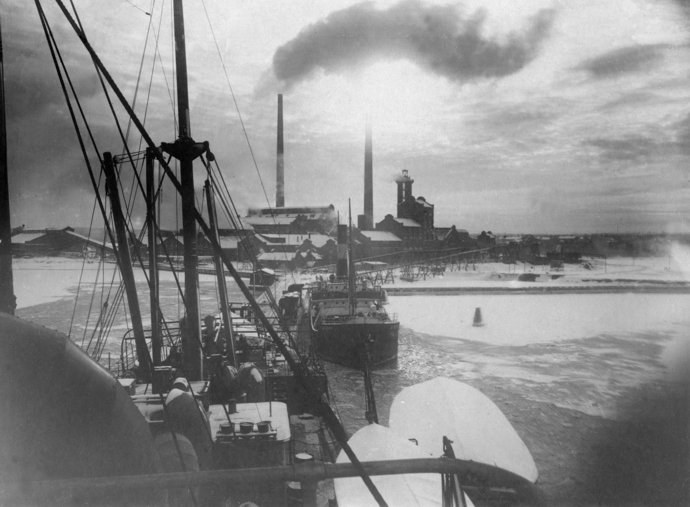
The most important industry for Gävle, both regarding economy and number of employees, has been Korsnäsbolaget (The Korsnäs Company). During 1897-1899, it moved its activities from Falun in Dalarna to Bomhus in Gävle. A sawmill, a planing mill, paper mill and other production of forest products made Korsnäs the country's leading exporter of timber products. Bomhus, southeast of Gävle, became a completely new urban area, with extensive housing projects, a church, schools and recreation facilities.
03 Stores
Since the founding of the city in the 15th century, Gävle has been an important center of trade. Until the 1800's, however, all trade was strictly regulated by the state. In 1846, the guilds were abolished and a great leap was made toward the freedom of trade that was legislated in 1864. After that, a number of shops and stores opened, offering a variety of goods and services.
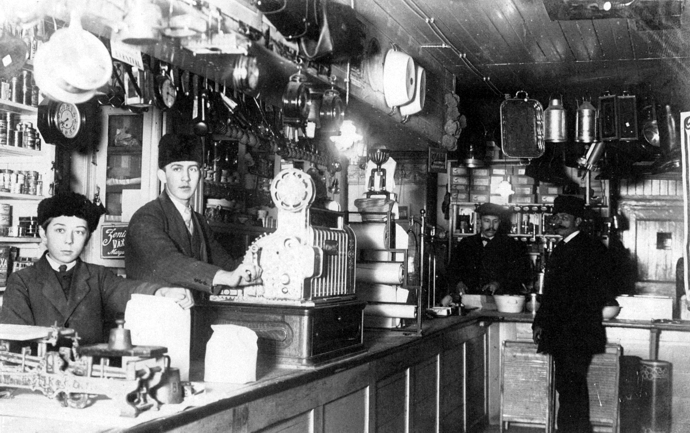
August Ohlsson's hardware store, at the corner of Drottninggatan (Queen Street) and Norra Köpmangatan (North Merchant Street), sold a number of goods for the modern household. Buckets, tubs, trays and washboards would make everyday life easier for people. The impressive cash register dominates the picture. It was a modernity that all the stores would soon acquire.
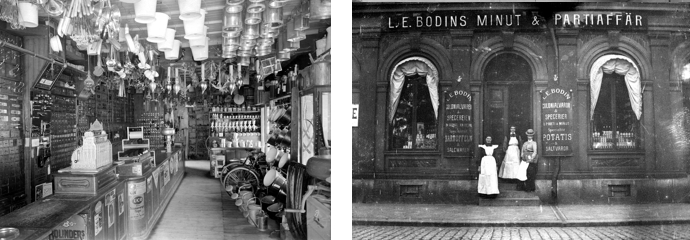
Gävle's mariners and merchants have a long tradition of importing goods from the four corners of the world. There was extensive wholesale trade with retailers in northern Sweden and the mining districts. In Gävle, produce reached consumers in L. E. Bodin's Minut & Partiaffär (Retail and Wholesale Store). Colonial goods and groceries were sold here, wholesale and retail. Potatoes and salted goods were specialties. Strangely enough, the store also has a sign in German, though it has a few badly spelled words.
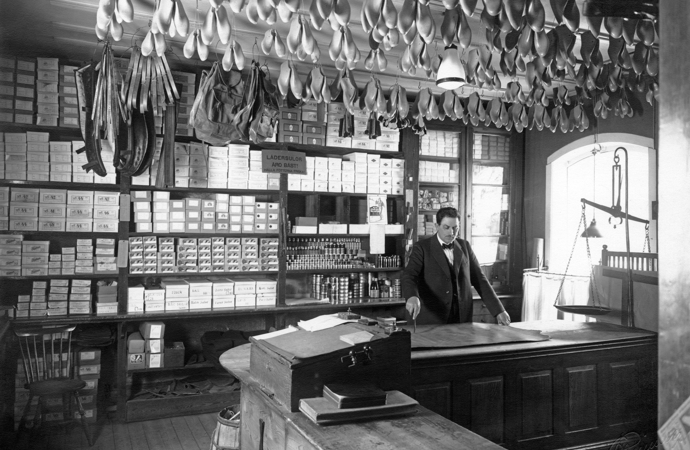
In Zimmerman's shoe store, on Nygatan, you could have your shoes made to fit. The many shoetrees hanging from the ceiling were used in shoemaking. The sign reads, "Leather soles are the best!" Zimmerman's shoe store still exists, though on more modern premises.
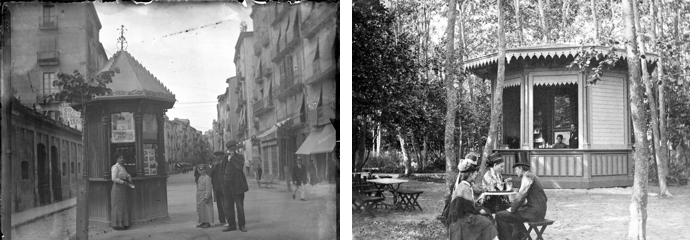
In the mid-1800's, was created a large park in the northwestern part of the city, south of the newly built cemetery, The famous park, Bois de Boulogne in Paris, served as a model. However, the Swedish park received a Swedish name, Boulognerskogen. Eventually, several cafés were established here. It became a well-liked pastime to stroll in the park and enjoy a cup of delicious coffee with snacks. At the same time as the customers in Stadsträdgården in Gävle enjoyed their lemonade, some customers on their way to the kiosk in Rambla de la Llibertat, Girona, stopped in front of the camera. One moment later perhaps they had bought something, a newspaper or sweets, however a moment beyond our reach.

Look at the beautiful hats the girls wore when they were gathering for this serious moment of perpetuation. Most pupils in Strömsbro were children to workers at the textile factory, Gefle Manufactur AB. Maybe it was the reason why they had such sensational hats. Would people in Girona have bought them, if they had been available in the Hatshop of Raimunda Crehuet?
04 Markets
Markets and squares have an intimate connection. In the city's large open spaces, people were able to sell their wares and to deliver their messages.
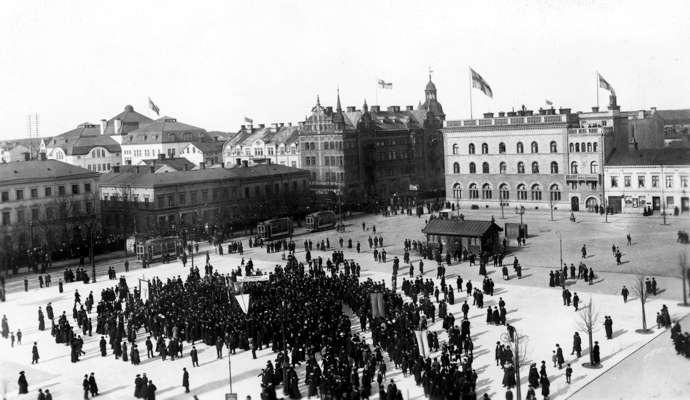
The people of the labor movement sought out places where they had the greatest chance of enlisting followers. Stortorget (Town Square) became a natural meeting place, for example, for the large May First demonstrations.
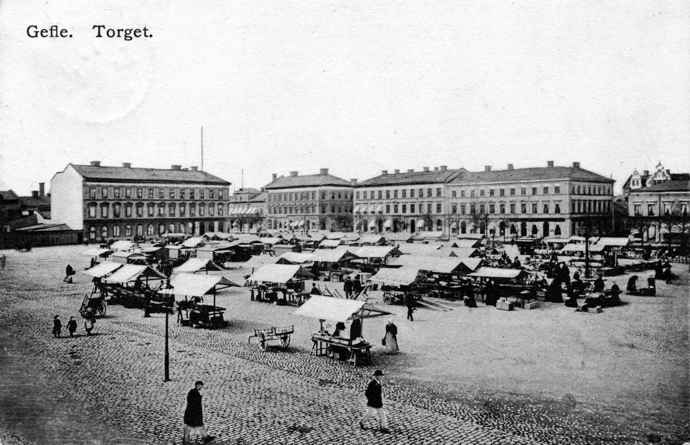
The Town Square was a natural location for travelling salespeople. Their outdoor stands were a picturesque addition to the city. City dwellers could find all kinds of knick-knacks and also food and clothing.

After the hay was harvested in surrounding villages, it was time for the farmers to sell what they didn't need themselves. In 1910, one could see this impressive row of horses and hay wagons on Town Square. Notice the young trees at Sant Agustí Square around the year of 1900 and notice the newly planted ones at the Town Square in Gävle. Some of the trees are still there in Gävle but some of them have been taken down because of age.

The most important market for people in general was the fish market, which took place each day at the Fish Dock in the Harbor Square. All kinds of Baltic fish were sold, but the most important fish was Baltic herring. There were innumerable ways to prepare it, but the best known to this day is smoked, so called "Bönaböckling", which was smoked using spruce. Grilled Herring, or "Sotare", is another traditional delicacy. The Fish Dock disappeared when the railroad expanded its yard in the 1950's.
One of the oldest markets in the city was located between the old Town Hall and Norra Strandgatan (North Shore Street). This image is one of the oldest existing images of Gävle, from between 1875-1880.
05 Transportation
On Brynäsgatan (Brynäs Street) in 1910, an old mode of transportation meets a new one. Since the invention of the wheel in the distant past, humankind has transported necessities in different types of carts and wagons.
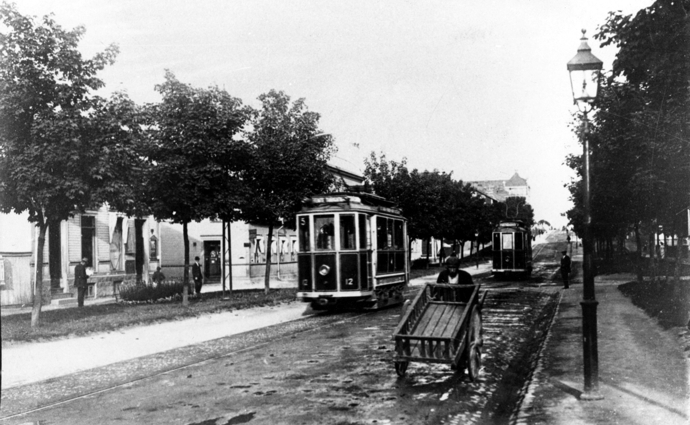
In 1909, there was a big breakthrough in the ability to travel throughout the city and environs. The red electric trolleys make their appearance.
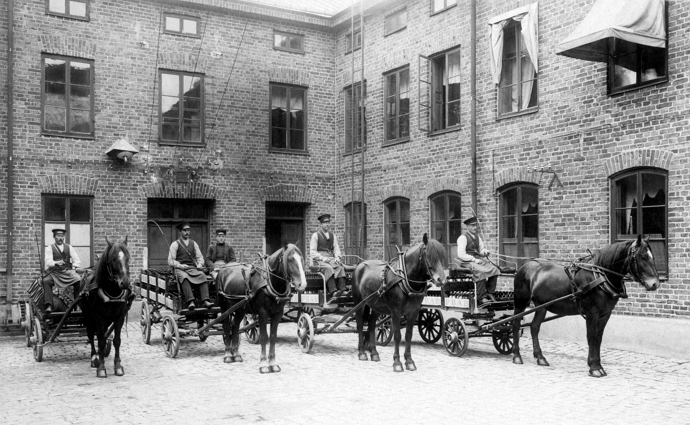
However, the city's transportation is still dominated by horse-drawn equipage, still an unbeatable mode of conveying all kinds of wares. Not least, the breweries' beer deliverymen were a given feature of city life. It's said that there was one draft horse that must drink a whole bottle of beer before he would start his morning rounds.

An important breakthrough, mainly for long transports, came with the railroads. Sweden's first railroad opened in 1856. As early as 1859, Gävle had its first railroad line. It ran westward, to Falun. In the 1870's, a connecting line was opened southward to Uppsala. Its station was named Gävle South. Connecting lines over Ockelbo and the Northern Mainline came in 1884.
Railway stations are special, like most places where you are waiting to go ahead. People meet, say good bye or strangers meet each other by coincidence connected by the joint reason, to travel somewhere. The little station, Gävle South, seems very similar to the one in Girona, the first place or the last place when somebody arrives to or leaves the city.
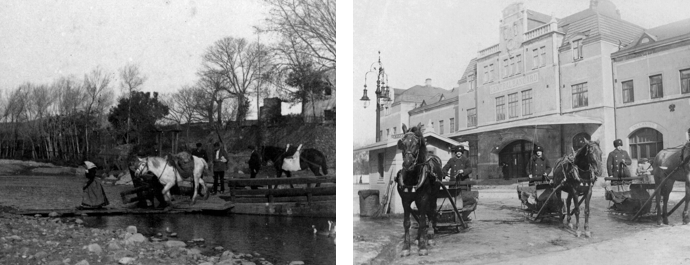
Sweden's snowy, cold climate has put great demands on winter transports. One easy way of getting around was with horse and sledge. Here also, we see the meeting of very old modes of transportation and new ones. The horse-drawn taxi drivers await train passengers at the Central Station, built in the 1870's.
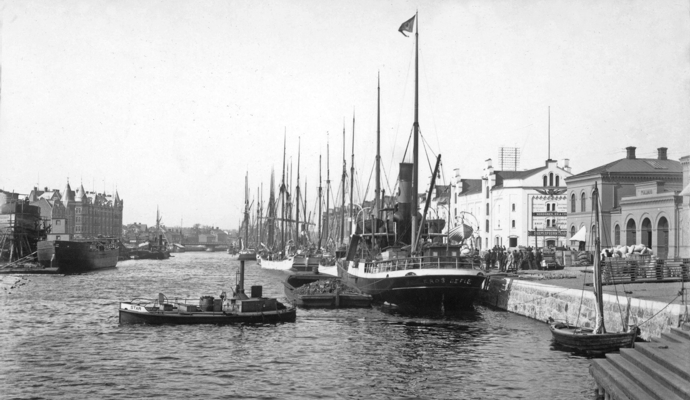
In spite of new modes of travel, by trolley and train, and by automobile, which makes an appearance, shipping is still the dominant mode of transportation during this period. Ships were still the superlative means of freighting large quantities of goods over long distances. The inner harbor was teeming with life and activities near the characteristic harbor warehouses. Concerning passenger traffic, Gävle's significance wanes. In the 1840's, the first wave of emigrants to the U.S. departed from Gävle on so-called Gävleskutor, sailing ships. The great emigrations of the 1860's and 1880's embarked for the most part from Gothenburg, on the west coast of Sweden.
06 Trades
The disastrous city fire in 1869 proved clearly the necessity of well-organized fire prevention. It would take more than twenty years before the fire department received proper facilities and equipment. However, by then it was even grander.

The well-known Stockholm architect, Ferdinand Boberg's fire station, opened in 1891, stands out to this day as a masterpiece of architecture. It still houses the city fire department. Both now as then, fireman was an admired and appreciated profession. The characteristic helmet type was seen in both cities. For us today seems the vehicles of the fire brigade in Gävle be quite primitive but the horses are new curried and are shining. Both images express proudness.
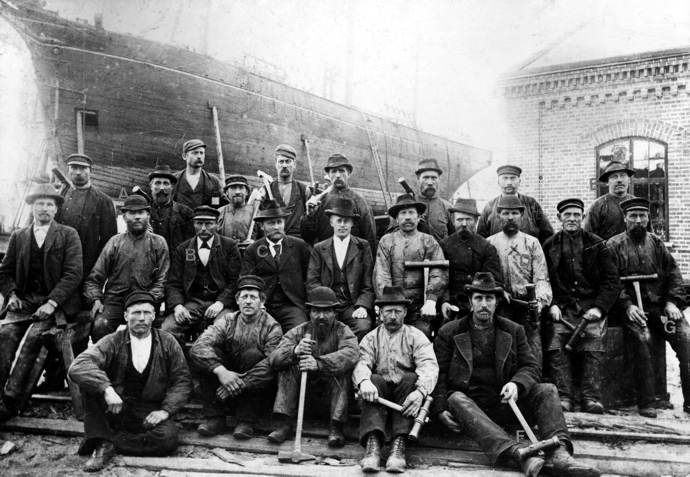
The role that shipping plays in Gävle's history cannot be overemphasized. Shipping companies and shipyards have a long history. The industries were at their peak during the time of sailing ships until the end of the 19th century. However, quite a few steam ships were also built before shipbuilding ceased in the 1960's. In this photo, from the turn of the century, 1900, you can see some of Gävle shipyard's skillful tradesmen.
The food industry has meant a lot to the city's economy, at least since the late 1800's. Trademarks such as Läkerol (from 1909), Pix (1897) and Gevalia (from 1920) are well known concepts throughout the country. Margarine, tobacco (Gefle vapen), beer and Swedish arrack punch (a liqueur) are other consumer items that were produced in the city.
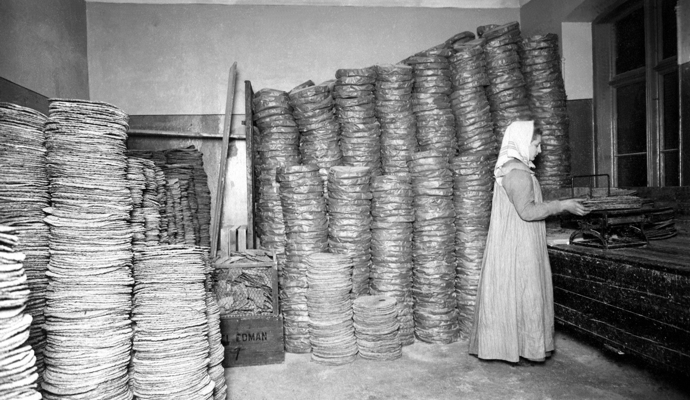
A smaller-scale production of food contributed also to the everyday life of the people in Gävle. Here we see piles of crisp bread at Edman's Bakery on Nygatan (New Street) in 1901.
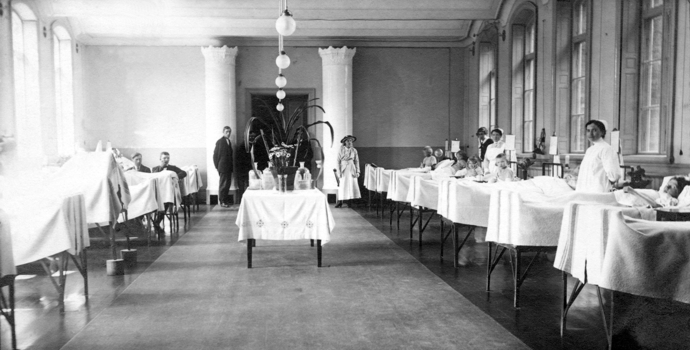
In 1887, Gävle Hospital was completed. New advances had marked health care in the late 19th century. The importance of minimizing the risk of infection was fully realized through strict hygiene and the use of sterile instruments. The photo from the early 1900's reflects the spirit of the time within health care.
By the end of the 19th century, it was apparent that the city's inner harbor was too small to handle the increased shipping traffic. Larger merchant vessels meant overcrowding, difficult to deal with in the docks. One survey from the 1890's pointed to greater need of a modern, new deep-water harbor.

The work began and in 1905, the harbor, Fredrikskans, with its own railroad line from the inner harbor, was inaugurated. In the photo, you can see the huge number of workers who built the railroad.
The navvies, who built our railways, were famous. There are many stories about these touring professionals, not always pleasant. What did the photographers want to expose in their images. In Gävle the new built rail can be seen in front of the navvies while it can be glimpsed behind the workers in Girona. Both working teams show their tools, in Gävle also their food baskets. There are women and children among the navvies in Girona unlike Gävle with just men. Managers and foremen with special clothes, stand of course in front of both teams.
07 Festivities
From time immemorial, the need for festivities has characterized human relations. During this period, Gävle was festively decorated several times.
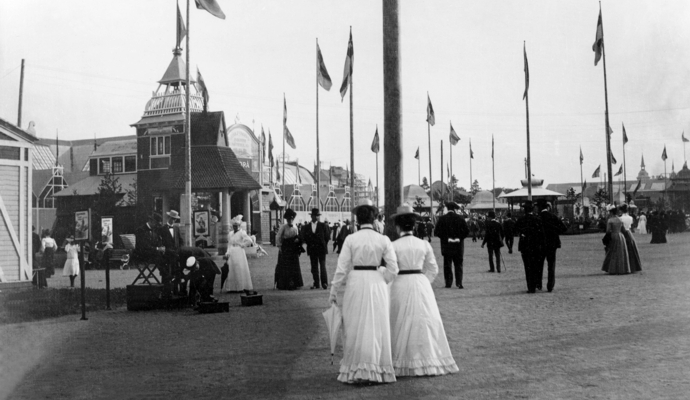
In 1901, there was a large national industrial and crafts exhibition in the city. A large area next to the military school (Borgarskolan) housed several newly built exhibition halls and more than fifty smaller pavilions. The exhibition reflected the belief in the future, associated with burgeoning industrialism and was a great success. There were royal visits and more than 170,000 visitors during 65 days in Gävle, which had at the time around 30,000 residents!

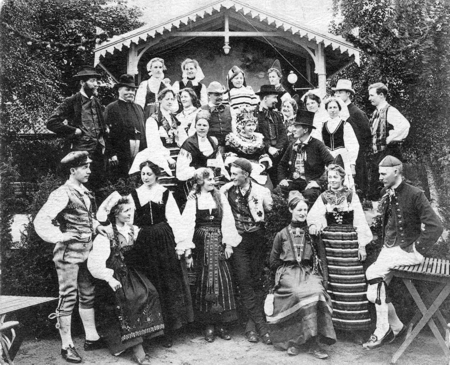
1914 was the year when the popular "Paper Festivities" began. The Folkets Hus Society (PeopleŽs House) and the local branch of the Swedish Social-Democratic Party organized them. The festivities were framed in spectacular paper backdrops that represented many places around the world: Arcadia, Alhambra and Japan. Amusement park, dance, theater, restaurant, fireworks, tooth athletes, comics, and celebrities
nothing was missing at the summer festivities!
Around the year 1900, the city's Temperance Lodge took over the previous Gästgivaregården (The inn) on Södra Kungsgatan (South King Street). There was a restaurant in the garden, open in the summertime. There was also a bowling green and a small stage, used to hold revues at Temperance Lodge parties. The place soon developed into the Summer Theater, a huge attraction for entertainment-hungry Gävleites!
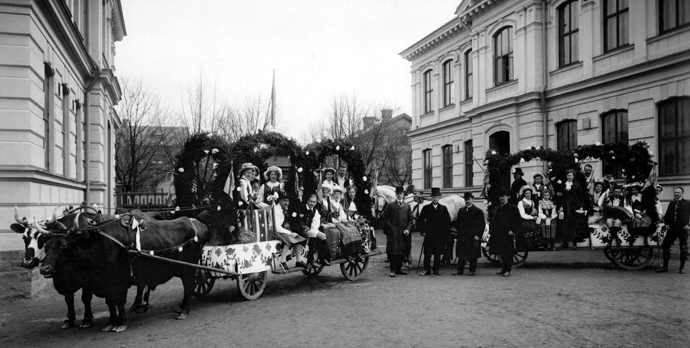
Beda Hallberg in Gothenburg in 1907, prepared to help children with tuberculosis. The widespread disease made it difficult for public healthcare to provide all the help that was needed. Hallberg had an idea, to sell a small paper flower during the month of May, a so-called Majblomma (May Flower), and donate the money to healthcare. Many local groups formed all over the country to help with the sales. As soon as in1908, this huge parade is seen on the streets of Gävle, all to collect money for sick children. The custom continues to this day and school children sell several million crowns' worth of May Flowers each year.
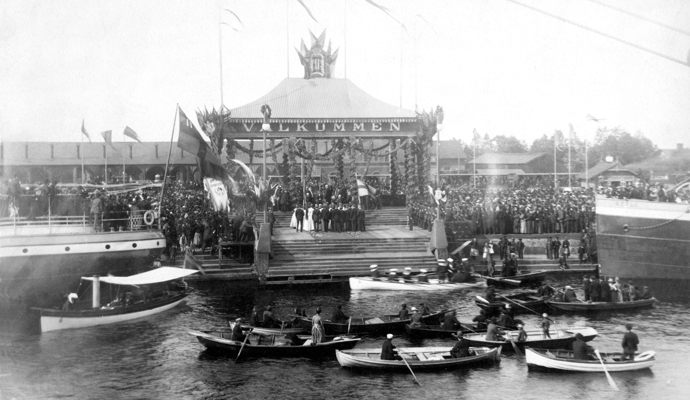
On August 19th, 1890, King Oscar II and Crown Prince Gustaf disembarked at the Customs House dock in the inner harbor for one day's visit to Gävle. The king received a rousing reception in the decorated city. The king visited, among other places, the Holy Trinity Church, Grapes Convalescent Home, the new hospital and took the train for a visit to the textile factory, Gefle Manufactur, in Strömsbro. After that there was a banquet at the Town Hall and the visit was concluded with a magnificent fireworks display.
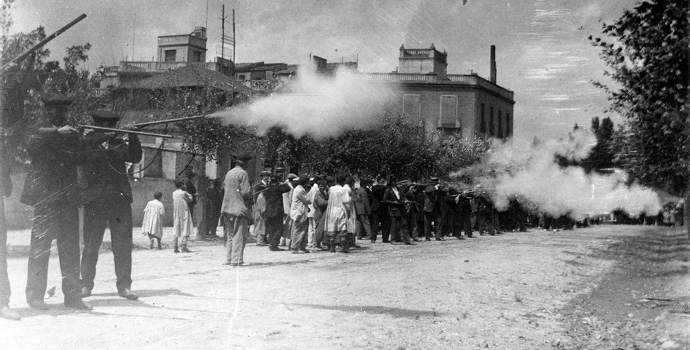
Both images give expression of nationalism and proudness. A royal visit to Gävle was a rare event and of course people flocked out in hope to see a glimpse of the king. The important sense of liberty was really worth to celebrate and remind of.
08 Sports
Early on, Gävle was a city of sports. It can be explained by the fact that Gävle, being a trade and shipping town, had close connections with countries such as England, where many modern sports originated. According to the English model, sports were an important part of the upbringing and discipline promised in boys' schools and universities.
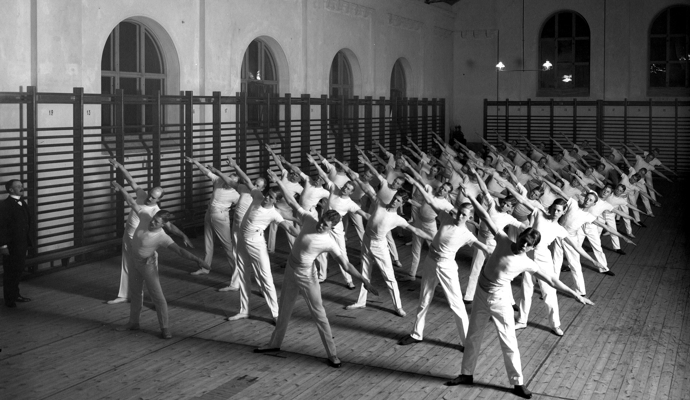
One of the earliest branches of athletics that was practiced in Gävle was gymnastics. A gymnastics institution was fitted at Gävle Secondary Grammar School and gymnastics became an important part of the curriculum. Gymnastics courses were also offered to older men and from 1840, women were also offered instruction in gymnastics.

Gefle Sports Club / Gefle Idrottsförening is one of Sweden's oldest sports clubs. It was founded in 1882. Several of the pioneers who ran the club were wealthy and two of them had been brought up in England. The first sports that were practiced were ski racing, ice skating and rowing. In about 1900, track and field and football (soccer) were the most popular sports in Gävle. From 1910 to 1920, Gefle Sports Club's top branches were running and pole vaulting.

Cold and snowy winters were natural conditions for winter sports. Skiing was previously a common means of transportation in Sweden. Among other things, it was a way for military units to travel. In the 1880's, skiing contests were arranged more often. The first skiing contest in Gävle was held in 1883.
Two competitions, two races, it is time to start, the bicycle race in Girona and the ski race in Gävle. But before that, the moments are going to be immortalized by photography. Most of the cyclists are looking straight into the camera like the skiers and functionaries in Gävle. It is a special and unusual moment. But the cyclists seem to be eager to get away. The skiers begin to shiver in the raw and chilly morning air, also anxious to get started and get the heat up.

A professional shooter in Girona and some beginners in Gävle. Women and girls who learn to handle rifles. The female marksman in Girona exudes safety and concentration. Even the audience is concentrated, apart from the man and the woman on the left who seem to say something to each other. Unlike the rest of the audience, their faces have been blurred because of the movement at the same time as the photo was taken. Wonder if the marksman got disturbed?
During the 1860's, many voluntary rifle clubs were formed in the country, as a complement to military service. Gävle Volunteer Rifle Association / Gefle frivilliga skarpskytteförening was started in 1860 and is still active. People from every level of society who were interested in shooting joined and, with the support of the local authorities, shooting ranges and training grounds were built. Within the shooting sport, there was also an emphasis on training and discipline. By the early 1900's, the marksmanship movement was more focused on sport and competition than on military defense.
09 Education
During his time as elementary school inspector, Justus Wockatz found huge problems in Gävle's elementary school instruction. On his own initiative, he had a teacher training school built in Hagaström in 1905. The aim was to give the teachers-in-training a more adequate education. In 1921, the school was transferred to the State.

For a modern observer, the image of the school staff in Girona gives a very old-fashioned impression, which inspires respect and obedience.
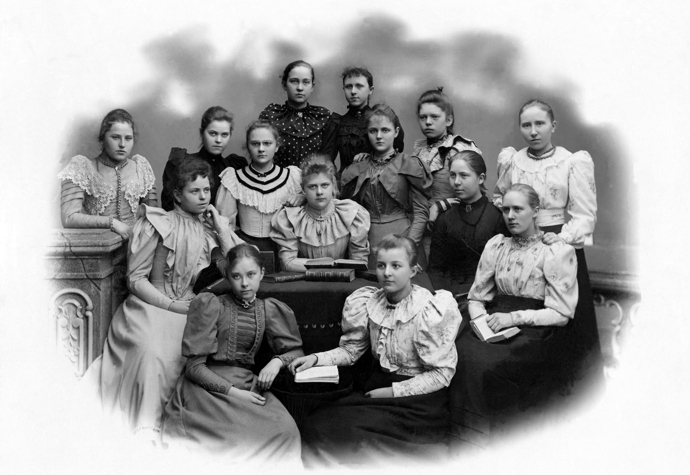
In 1877, the newly built Själanderska School was opened. The building on Rådhusesplanaden (Town hall Avenue) is still standing. For a long time, the school was run privately by the educational enthusiast, Miss Carolina Själander, and eventually was taken over by the municipality. The most well known student to attend is the author, Agnes von Krusenstjerna, hotly debated in Sweden and known for her erotically characteristic novels, which were not appreciated by everyone.
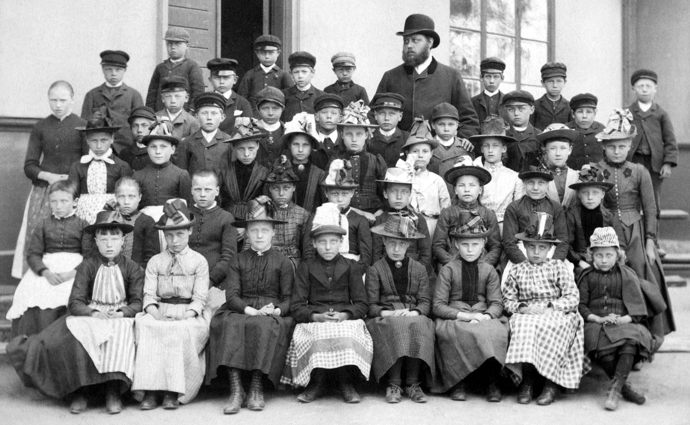
Private and municipal schools have coexisted in the city for a long time. In Strömsbro, the so-called Bränneriskolan (The Distillery School) was opened in 1832. It received its name for the state distillery that was built in 1776. The distillery has ceased to exist, but the school is still there today.

Elementary education, mandatory from 1842, contained not only theoretical subjects. Crafts and cooking were seen as important subjects in preparing for adult life. Here we see girls concentrating at their spinning wheels.

After the town fire of 1869, several large elementary schools were built. Most of them were large stone structures, designed by the town architect, Erik Alfred Hedin. In 1880, Stora Islandsskolan was opened, in 1890 Södra Gosskolan and in 1907, Brynässkolan. They were imposing buildings, which must have made the students feel small and vulnerable. However, there are alternative pictures. Stigslunds School was built in 1886, in wood, with much softer contours. The barefooted children look happy and seem to thrive, especially the boy who is up on the rooftop by the flag! Wooden school buildings may not have been usual in Girona. Were pupils in Girona allowed to be barefoot?
10 Family
Photography had come to Gävle by the early 1840's. Foreign photographers appeared in the city during the summers and took portraits. In 1855, Erik Östman established the first photography studio in Gävle. From the 1860's, several photographers were active in the city. In the archives of the portrait photographers, you can study the families of different decades.

Early photographs were always taken in studios because of the long exposure times. Technical improvements made it possible to photograph everywhere that there was enough light. This picture is unusual in that it shows children in an everyday environment, without stiffly posing.

We canŽt be sure but there is something telling us it is Sunday. The family members are dressed up and gathered. In the garden at Master baker Eriksson, the baker himself is not at work, but surrounded by family and friends in a peaceful moment a Sunday afternoon in the early summer, while the fruit trees are blooming. In Girona, the author himself has taken the photo of his family, most of them patient and happy except the youngest who probably wants to run away freely in the park without respect for the seriousness of the moment.
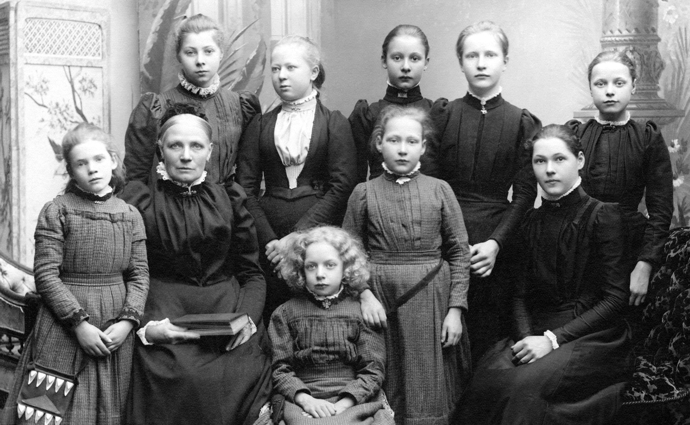
The family's situation could then, as now, take different forms. Not all children grow up with their parents. In Gävle, there were several orphanages. One of them was Enskilda barnhemmet Salem för flickor, a girls' orphanage. Sorrowful faces meet us in this picture, taken in the 1880's. The stern matron, Sofia Grape, seems to have good control of the girls.

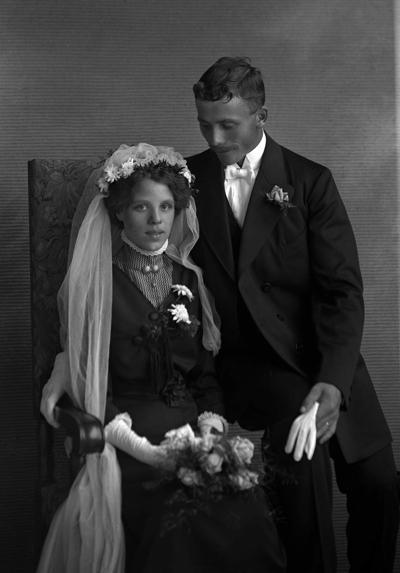
Erik Hammar is called Gävle's own cinema king. In 1905, he opened the city's first permanent movie theater, the Olympia. In 1912, he started the first modern one, Röda kvarn, and in 1917, the Regina. Hammar, besides being a movie theater owner, was a skilful documentary filmmaker. Part of his production still exists. In this picture, from 1914, you see him with his family, with five sons in sailor suits, typical of the times.
There is something similar between the only son of the family from Girona and one of the sons of family Hammar, the one to the right. Maybe it is the hairstyle. The boys have the same kind of clothes like the Catalan girls who wear similar white dresses to emphasize togetherness.
Most of the existing family portraits were taken on formal occasions, at confirmations, graduations, birthdays and weddings. In 1913, the Jansson bridal couple was photographed in Berna Roth's studio.
11 Religion
Christianity came to Sweden late in the 10th century in the form of Roman Catholicism. During the 16th century, Evangelical Lutheran teachings came to dominate. The church was controlled by the state until the year 2000.
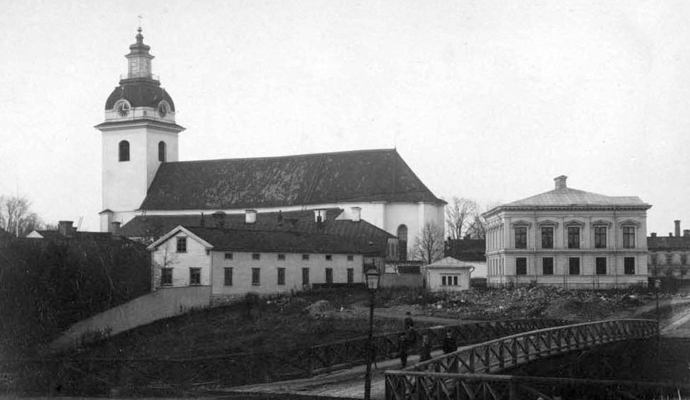
Trinity Church in Gävle was built in the 17th century, after a fire had destroyed the medieval church that originally stood there. The priests had great sway and control of the population. For example, the state church was responsible for the census and, until 1911, ran the city's schools.

In 1858, religious laws became more lenient and gave Swedish citizens the opportunity to join other religious groups. The free churches that were formed had a larger emphasis on personal Christian faith and a more personal involvement. In Gävle, a Baptist congregation was formed in 1858. Initially there were only seven members, but by 1900, it had increased to 436 members. To make room for everyone, ground was broken in 1902 for the impressive Immanuel Church.
The churches have a lot of visitors in Gävle as well in Girona. It was moments for contemplation but also an opportunity to meet friends and have some secular information.
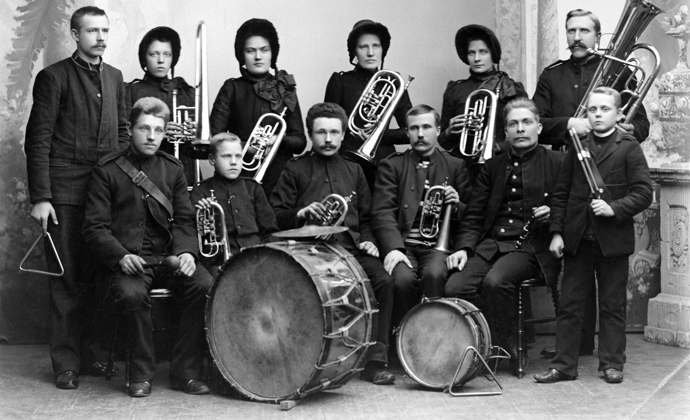
Several new religious groups were founded during the last half of the 19th century. In 1855, a Mission Covenant Church was founded and grew to be the city's largest free church, with around 1300 members in 1900. In 1870, a Methodist congregation was started and soon had two churches. The Salvation Army, originating in England, was established in Gävle in 1888. Music was an important feature of their mission. They appealed often to the poor and their motto was "soup, soap and salvation".
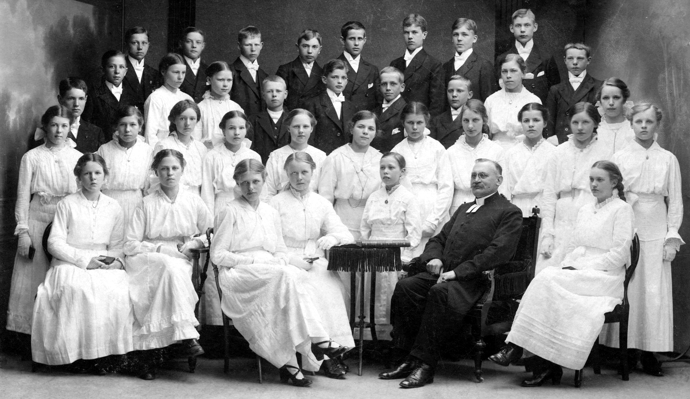
Most young people who belonged to the state church received confirmation classes at the age of fourteen or fifteen years. Confirmation acknowledged baptism, and showed that the young adults consciously accepted their faith. The Baptists, for example, did not practice infant baptism, they waited to be baptized until each person decided to affirm one's faith.

Religious practices in Sweden haven't been very extrovert and expressive. The church environments have been stark and religious rites have been performed, with few exceptions, outside of the church. This picture of the funeral of proletarian pioneer, Olof Danielsson, shows how the workers seized the occasion to make their message public in a time when it was difficult to get permission to demonstrate. The photograph does not, therefore, give us much of an impression of religious faith as of the belief in the growing labor and union movement. The religious impression is much bigger in the photograph from Girona which shows the funeral of the bishop Francesc de Pol 1914.